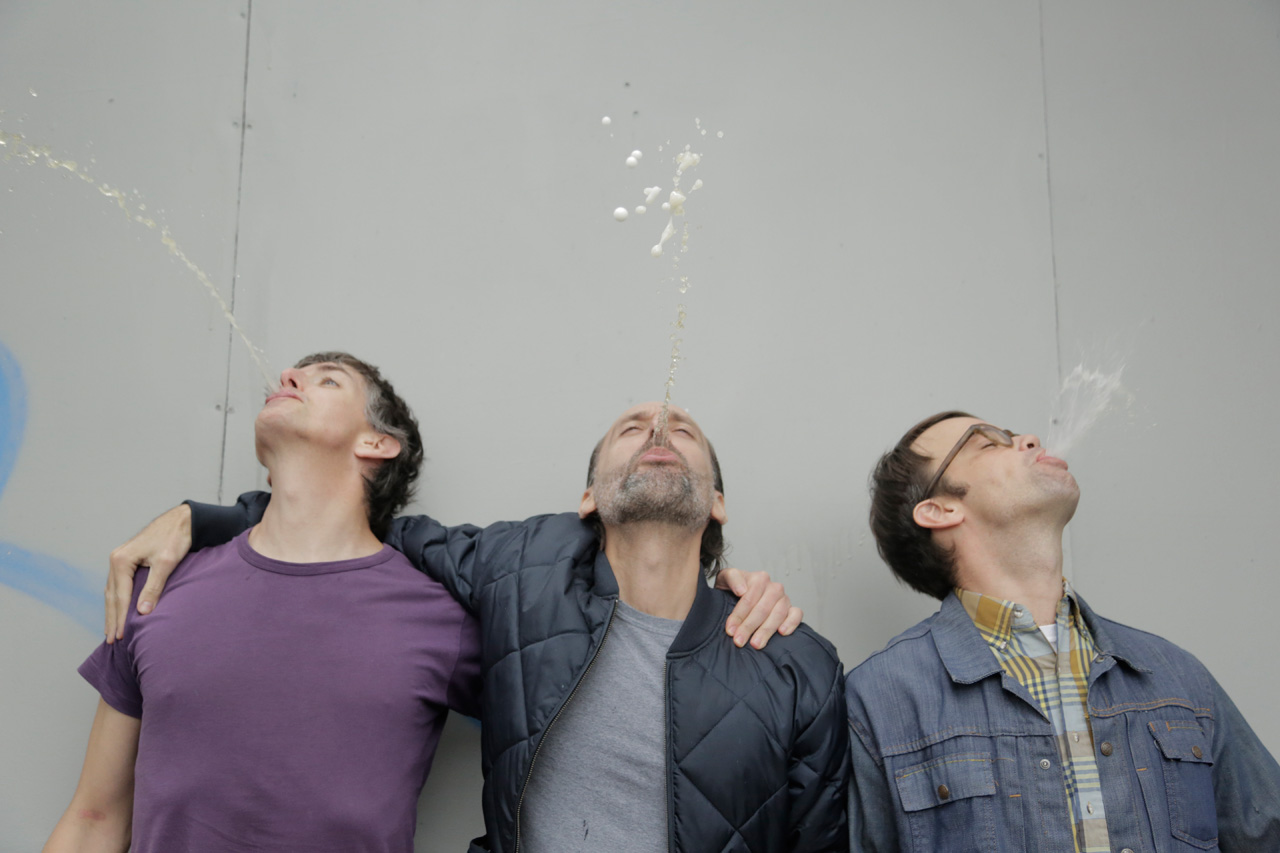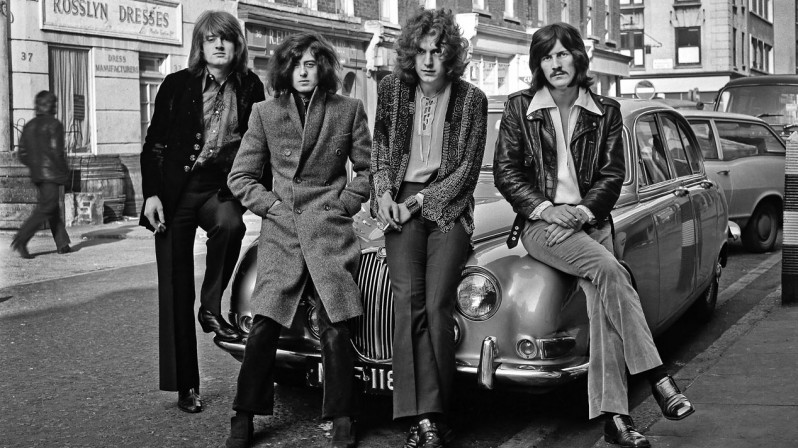“I was introduced to Led Zeppelin by my older neighbor, Andrew Thomas,” Trans Am guitarist Phil Manley tells TeamRock. “He played me Led Zeppelin I. From the first note, I remember being transfixed – frozen, unable to move. I made a cassette copy of his LP and listened to it over and over again. I had seen Led Zeppelin graffiti and had assumed they were satanic. This was before there was such thing as the “classic rock” format on the radio, so to an 11-year-old me, Led Zeppelin was esoteric.”
Having cited Led Zeppelin as a key influence on their new album California Hotel, Manley and drummer Seb Thomson select their all-time favourite Zep moments.

Good Times, Bad Times (from Led Zeppelin, 1969)
Phil: “I recently read a book titled Sound Man, which is Glyn Johns’ autobiography. He was an engineer who recorded many classic albums including Led Zeppelin I. In the book he explains how he couldn’t believe how great the band sounded coming out of the speakers. He didn’t really have to do anything. It was all about the band. From the opening chords of the first song on their first album, it’s as if Led Zeppelin already knew they were the best.”
Immigrant Song (from Led Zeppelin III, 1970)
Phil: “Trans Am first played with Oneida in Bloomington, Indiana. Oneida had prepared a CD to play before their set which was the first 16 bars of Immigrant Song looped for 73 minutes. That’s the portion of the song before the first chord change. It set the stage pretty well for their opening song which was Sheets Of Easter, which is one chord hammered over and over relentlessly for 20 minutes or more. Hypnotizing.”
Ramble On (from Led Zeppelin II, 1969)
Phil: “I remember being stoned for the first time in the back of my friend’s Honda Accord parked in a dark cul-de-sac in the D.C. suburbs, making out with a girlfriend and listening to Ramble On. One of the channels on his stereo was fried, so when the harmonized guitar solo came in, it was missing the harmony. My mind was blown. I had never noticed that the solo was in two parts and hard-panned in opposite channels. It all seemed like one magical part. Jimmy Page is truly a wizard.”
Down By The Seaside (from Physical Graffiti, 1975)
Phil: “As a recording engineer, 9 out of 10 drummers ask me to record their drums to sound like John Bonham’s. I realise they’re asking for the sound on When The Levee Breaks, but Zeppelin is not so one dimensional. This track shows their poppier side. It’s not heavy, it’s wistful.”
Song Remains The Same (from Houses Of The Holy, 1973)
Phil: “Trans Am used to cover this song as part of a Zep medley which we used to play live. Other songs included in the medley were 10 Years Gone and Celebration Day. After playing the medley as an encore at a show in D.C., at the well known punk venue The Black Cat, a disgruntled audience member was overheard saying, “It’s as though punk never happened!”
Which brings up an important point. Punk was a reaction to bands like Zeppelin. I know plenty of music nerds who panned Led Zeppelin because they were bloated and mainstream. This decision wasn’t necessarily based on their music, but on their style or how they were categorised. Punk is a tribe and Led Zeppelin were the chiefs of the opposing tribe. Coming of age in the late 80s/early 90s, Led Zeppelin had been disbanded for nearly a decade. To us, we didn’t have to choose one or the other. We liked the Buzzcocks and Bad Brains as much as we liked Pink Floyd and Led Zeppelin.”
The Wanton Song (from Physical Graffiti, 1975)
Seb: “I tried to control myself but I couldn’t help it – for the five Zep tracks I chose, I mainly [speak] about drummer John Bonham. He made such an impression on my young mind that to this day I feel a mysterious and magical chill when hearing these songs.
This song features some of my favorite Bonzo playing, but for some reason is always overlooked. Pagey’s syncopated staccato riff leaves so much room for Bonzo to improvise 16th note comping with the kick and snare. I love that this sounds like a studio realisation of the James Brown-influenced jams the band did live. I’m not sure why this riff isn’t imitated more.”
In My Time Of Dying (from Physical Graffiti, 1975)
Seb: “Although the majority of this track is a (probably) regrettable reworking of songs recorded by Blind Willie Johnson and Josh White in the 1920s and 30s, at around 3:50 it morphs into a more original Zep rhythmic workout. The way Bonzo adds the single stroke snare rolls into the beat is incredibly powerful, and the groove only builds in intensity as he adds the 16th note hi hat. I remember playing this as a kid on the stereo and my dad yelling at me to “TURN IT UP!” because the drums were kicking so much ass.”
Achilles Last Stand (from Presence, 1976)
Seb: “While the two previous tracks are notable for their combination of rock power with funk swagger, this track is almost a primitive version of the New Wave of British Heavy Metal. Jonesy’s galloping bass must have been an influence on Iron Maiden’s Steve Harris. I also love it for the dark vibe, most probably having something to do with Robert Plant’s car crash suffered before the recording. The frantic yet tight drum fill at 2:30 might be my favorite Bonzo moment of all time. Phil, do you remember when we got really high, I said “You’ve got to check out this track!” I put it on, and then I walked out without saying anything.”
Kashmir (from Physical Graffiti, 1975)
Seb: “Here we have the perfect example of what so many young drummers misunderstand about what made Bonzo so great. Drumming is not a one dimensional competition like the 100-yard-dash, it is music, and his choice to lay back and be minimal helps the riffs be so hypnotic. So many technical drummers today can play this but not actually play it.”
Fool In The Rain (from In Through The Out Door, 1979)
Seb: “I’m not a huge fan of what the other instruments are doing in this song, but the groove Bonzo lays down here is one of the top 5 beats every drummer should try to learn – and I do mean try. This half time shuffle is more specifically a “Purdie Shuffle”, a beat created by session drummer Bernard Purdie that features critically placed ghost notes on the snare. Purdie can be heard playing this on the Steely Dan track Home At Last off Aja. Bonzo made his own incredibly powerful and loping version of it for Fool In The Rain, and it made such an impression on drummers everywhere that even time master Jeff Porcaro used a version of it for Toto’s Rosanna. This track also shows that part of Bonzo’s magic was that he listened to a lot of R&B and pop music, and not just “heavy” music. This is why so many of his grooves have a sex appeal that other 70s hard hitters miss.”
Trans Am’s new album, California Hotel, will be released on April 22nd via Thrill Jockey Records. They will be heading out on a European tour in April.
Eddie Kramer's guide to Led Zeppelin's Houses Of The Holy
Led Zeppelin: The Story Behind Led Zeppelin II
It's official: Led Zeppelin's Stairway is the greatest guitar solo ever
